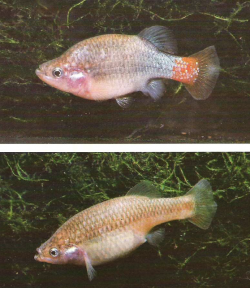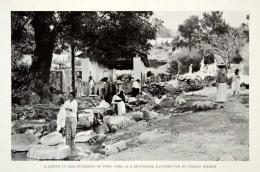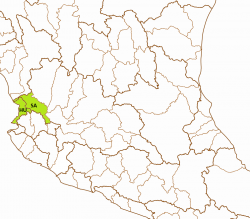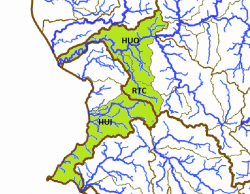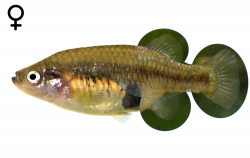- HOME
- WHO WE ARE
- NEWS AND DATES
- GOODEIDS
- PHYLOGENY
- ARTIFICIAL KEY
- GOODEID SPECIES
- BIOLOGY
- ENVIRONMENT
- CONSERVATION
- PROFUNDULIDS
- MEMBERS AREA
"Xenotoca" eiseni
English Name:
Redtail Splitfin
Mexican Name:
Mexclapique (erronously: Mexcalpique) cola roja
Original Description:
RUTTER, C. (1896): Notes on Fresh Water Fishes of the Pacific Slope of North America. Proceedings of the California Academy of Sciences (2) 6: pp 245-267
Holotype:
Collection-number: Museum of Natural Science - Louisiana State University, Cat. No. LSUM-4999.
The types are four specimens, the largest one of 33mm total length, collected by Gustav Eisen and F. Vaslit in November 1894.
The left pictures show both sexes of "Xenotoca" eiseni from 1978 (O. Böhm) and belong to the earliest we have from this species, the rare photo on the right side shows a spring in Tepic in the early 1920's, where native women are washing their laundry. Probably the type locality of "Xenotoca" eiseni looked similar, and it was definitely used by the people in the same way:
Terra typica:
The types were collected in a branch of the Río Grande de Santiago at Tepic in the federal state of Nayarit.
Etymology:
The species is named for its discoverer, the Swedish polymath Gustav Eisen, who was at this time Curator of Archaeology, Ethnology, and Lower Animals of the California Academy of Sciences.
This species belongs to an undescribed genus, but until the changement has happened, it stays integrated in Xenotoca. The genus Xenotoca was erected for Characodon variatus by Hubbs and Turner in Turner, 1937, because "this species differs from Characodon (lateralis) in numerous internal as well as external features. Characters distinguishing Xenotoca from Characodon involve the ovarian anatomy, the form and structure of the trophotaeniae, and some superficial features". The generic name can be derived from the ancient Greek with the word ξένος (xénos) meaning strange and and τόκος (tókos) offspring. Xenotoca can therefore be translated with "a strange type of offspring".
Synonyms:
Characodon eiseni Rutter, 1896
Characodon variatus Regan, 1907
Distribution and ESU's:
The Redtail Splitfin is endemic to the Mexican federal state of Nayarit. It was historically known from springs and creeks along the Río Mololoa around the town of Tepic, including the Laguna de Tepetiltic in its headwaters, from the adjacent Río Santa Rosa headwaters, both affluents of the Lower Río Grande de Santiago about 30-40km (beeline) away from the Pacific, and from the Arroyo Compostela including the Laguna de San Pedro, Río Huicicila drainage, 25km S of Tepic. It probably only persists in a spring in Seis de Enero, Río Santa Rosa drainage, and the Arroyo Compostela. Affiliated to three river drainages, three subpopulations can be distinguished: The Río Mololoa subpopulation (type subpopulation), the Río Santa Rosa subpopulation and the Río Huicicila subpopulation. The bold names are the ones officially used by the Instituto Nacional de Estadística y Geografía; nevertheless, other ones might be more often in use or better known and therefore prefered.
ESU ist short for Evolutionarily Significant Unit. Each unit expresses an isolated population with different genetic characteristics within one species. ESU's can be defined by Molecular genetics, Morphology and/or Zoogeography and help in indicating different phylogenetic lineages within a species. The abbreviation for an ESU is composed of three letters of the genus, followed by the first two letters of the species name and an ongoing number in each species.
In "Xenotoca" eiseni we distinguish two ESU's: Xenei1 encompasses the populations from the Río Santiago (Manantial 6 de enero, Manantial el Sacristán, Rio Santiago). Xenei2 is the abbreviation for fish from the Río Compostela. The former Xenei3 has been renamed into Xenly1 ("Xenotoca" lyonsi), Xenei5 is now Xendo1 ("Xenotoca" doadrioi), Xenei4 belongs likely to "Xenotoca" lyonsi (see there) or represents a distinct species.
The left map shows the Río Santiago-Aguamilpa (SA) basin from the Hydrographic Region Lerma-Santiago and the Río Huicicila-San Blas (HU) basin from the Hydrographic Region Huicicila on a Mexico map. The Redtail Splitfin is known from the Río Tepic (RTC) infrabasin around Tepic, where it is now probably Extinct, and from the Río Huaynamota-Océano subbasin (HUO), where it still occurs in the spring area of Seis de Enero. These populations from the Río Santiago-Aguamilpa basin are regarded as ESU Xenei1. Fish from the Arroyo Compostela, Río Huicicila subbasin (HUI), Río Huicicila-San Blas basin, belong to the ESU Xenei2. All of these subbasins are shown on the right map:
Status :
International Union for Conservation of Nature (IUCN): Endangered
Distribution and current conservation status of the Mexican Goodeidae (Lyons et al., 2019): Endangered/declining: „This species was recently split into three: Xenotoca doadrioi, X. eiseni, and X. lyonsi (Domínguez-Domínguez et al., 2016). As currently defined, X. eiseni is known from the upper Santiago River basin near the city of Tepic, and the upper portions of direct Pacific Ocean drainages near the city of Compostela, all in the state of Nayarit. We recognize two ESUs based on genetic differences. Xenei1 is endangered and is found in the Santiago River basin near the city of Tepic. Many populations have disappeared owing to lack of water, habitat destruction, and introductions of non-native species, and only a handful of small populations remain. Xenei2 is also endangered and known from the direct drainages to the Pacific Ocean near the city of Compostela. It too has declined dramatically for the same reasons as Xenei1 and survives in small numbers in just a few springs and streams.“
NOM-059-SEMARNAT-2010: Categoría de riesgo (Category of risk): P - En Peligro de Extinción (in danger of extinction)
Habitat:
This species inhabits springs and spring-fed pools, lakes, creeks and turbid rivers. The water is generally clear to turbid or muddy, the predominant substrates are mud, silt, sand, rubble and rocks. the currents are none to moderate. In some localities, there can be found sparse vegetation, mainly green algae, Eichhornia, Lemna, Potamogeton, Typha, Nasturtium and Ceratophyllum, in other localities, aquatic vegetation is absent. The Redtail Splitfin prefers depths less than 1m.
Biology:
Young are produced at least in March and April and probably over a long reproductive period. Under captive conditions, when fish are maintained at 24-27°C, broods appear in all months of the year.
Diet:
Adults have got strongly bifid teeth in the outer row and conic teeth in the inner row. Following Fitzsimons (1972), this species is omnivorous, although plant material forms the greater volume of food. The gut is as long or sligthly longer than the total length what supports Fitzsimons assumption. Besides plant material, they seem to feed also from worms, crustaceans, insect larvae, detritus and aquatic insects.
Size:
The maximum known standard length is 75mm (Miller et al., 2005).
Colouration:
Fitzsimons gave in 1972 an extremly good description of the colouration: "In males, the posterior half of the caudal peduncle is orange to red-orange. This bright colour continues well onto the membranes of the caudal fin or at least persists as a pale yellow-orange zone at the fin-base. The anal fin is similarly coloured except for the shortened anterior six rays which remain clear. The dorsal may be dusky to dark in some populations and pale yellow-orange in others. In large males a narrow median dark stripe runs through the dorsal fin. Paired fins are pale yellow (large mature males) or clear (immatures). A bluish-black band, equal to or sligthly larger than an eye diameter, extends from the upper edge of the opercle posteriorly along the midside, becoming indistinct near the midlength of the pectoral fin. A similar dark band, beginning below the midlength of the dorsal fin and running back onto the caudal peduncle, occurs in males 40mm SL or larger. The top of the head, nape and back are olive-brown to dusky; these colours grade into lighter shades ventrally. The sides of the posterior third of the body and anterior half of the caudal peduncle range in colour from dull blue-black to iridescent turquoise. The chin, throat and belly are pale yellow to off-white. Ground colour in females, as in males, is olice-brown. Pigmentation is most dense dorsally and fades out down the sides to the venter. Scattered gold reflections are sometimes seen on the head, nape and dorsal surface of the caudal peduncle in large females. Inconspicuous wedge-shaped brown bars occur above and below the midside of the caudal peduncle and above the midside of the body from the anal origin forward to slightly anterior to the dorsal origin. The abdomen is pale white to yellow-white. Mature females have an iridescent blue-black bar behind the eye on the upper part of the opercle. A prominent black blotch on the lower abdomen begins at the anal fin and extends forward about halfway to the base of the pelvic fin. Paired and median fins are usually clear to pale yellow but in at least one population red-orange pigments are present on basal membranes of the caudal fin of mature females."
Sexual Dimorphism:
Males and females of the Redtail Splitfin are easy to distinguish. A safe characteristic is the Splitfin in males, means the for Goodeinae typical mating organ formed by a notch after the first seven shortened rays of the Anal fin. Additionally, male "Xenotoca" eiseni have a bigger Dorsal fin than females. The difference in colouration is clear and very distinct. While females are simply brown or brownish grey with a darker middle line, stronger in the posterior section, clear fins and a prominent gravity spot, males have a typical red caudal fin with the colour extending on the caudal peduncle. The following section of the posterior half of the body is iridescent blue, at least on the upper half of the body to the Dorsal fin, followd by a grey zone extending to the head. Males can display a black area above the pectoral fins and an orange Anal fin, but these characters can't be found in all individuals. The belly is in both sexes lighter than the back.
Remarks:
Meristic data from this species overlap with Xenotoca variata, and this was the reason, why several authors (Regan, 1906 and 1908, Hubbs, 1926, Hubbs & Turner, 1939, Romero, 1967) synonymized "Xenotoca" eiseni with Xenotoca variata. Though Turner had seen this species (including adult males) alive, he confirmed inexplicably the synonymy of these two species (1939). Miller saw this species and the recently described lyonsi in the habitat (1955) and asked Mendoza to compare trophotaenia and ovary (1965), and the results made clear, that the species were different. Finally Fitzsimons (1972) confirmed, again after the hint of Miller to compare the species of the genus Xenotoca in many accounts, that "Xenotoca" eiseni was a distinct species. As this species was seen as synonym of Xenotoca variata for many decades and no drawing or painting of the types was presented, it lasted until the 1970's until this species was pictured for the first time. The first photos were presented in Fitzsimons' paper from 1972, but the pictures show fish from the Tamazula river, so therefore "Xenotoca" lyonsi. Though kept in aquariums since Millers collection from 1955, it lasted until the early 1970's, when the first specimens reached Europe. While Günther Entlinger mentioned Friedrich Fröhlich from Lübeck receiving the first individuals from the American Livebearer Association in 1974, Jacobs claimed (1975), they reached Europe in the second half of 1973 via several enthusiasts. The first option is comprehensible and seems therefore to be the correct one. First photos of this species appeared in German aquarium magazines as late as 1975, if it happened in US ones earlier, is not confirmed so far. Hints are welcome! The photos of Otto Böhm from 1978 in the chapter "Holotype" show a pair of the original imported strain, going probably back to Millers collection in 1955. However, a "spotted strain of eiseni" appeared in Germany already in the 1970's and Jacobs interbred them with the original strain. Harro Hieronimus (1995) suggested, that this variety may have represented the types described by Rutter, others (Erich Schraml, pers. comm.) are of the opinion, the fish were originally from the Río Tamazula, which is now "Xenotoca" lyonsi. The photos Schraml made of his fish (see "Xenotoca" lyonsi) look very close after lyonsi, so it is quite likely, that the spotted strain were indeed the first imported representatives of this species. After Jacobs interbreeding experiments, it might be, that the aquarium strain of eiseni is partly a hybrid of these two species.
Already hybridisation studies of Fitzsimons (1972) revealed a close relationship of this species with "Xenotoca" melanosoma, but not with variata. The Redtail Splitfin, its closest relatives (doadrioi and lyonsi) and the two species of Black Splitfins do not belong to the genus Xenotoca. Shane Anthony Webb (1998) proposed a new generic name in his thesis for these species, that has not been published officially (Xenotichthys). The reason therefore is the US-American jurisdiction, that a thesis doesn't count as an official publication. Therefore R. R. Miller segregated the generic name by quotation marks, a system, we follow in the GWG.
The original Redtail Splitfin, by the middle of the 1950's, was the first species of Redtail Splitfins being held in aquariums. With the description of "Xenotoca" doadrioi and lyonsi in 2016, a lot of people became confused and are partly still not able to address the species correctly. The admittedly minor differences in meristics are barely to see with the naked eye, so people try to see differences in colouration. Here the golden band or saddle is typical for doadrioi males. Though there is also a kind of band in eiseni and lyonsi, this band is indistinct and grey in contrast to shiny golden in doadrioi, and a yellow or orange cheek or belly is typical for doadrioi males as well. The Tamazula Redtail has the belly white or whitish and separated from the back quite clearly, in eiseni the separation to a lighter coloured belly is indistinct, and the belly is usually not white. The original Redtail, "Xenotoca" eiseni, is honestly spoken optically almost not to distinguish from lyonsi. So, knowing the origin of fish and correctly passing it over to other keepers and breeders is extremely necessary in most of the Goodeid species, especially in the Redtail-group. Otherwise it results in hybrids and makes the whole kept population worthless for conservation efforts, and even dangerous by being passed them over to the next breeder with wrong location data. In contrast to its wide distribution in the hobby, "Xenotoca" eiseni is rare in nature and higly threathened. The population from the Arroyo Compostela is restricted to a few hundred metres before this creek reaches the town of Compostela and becomes too polluted, and only one other population in the spring area of Seis de Enero is known and extant. This fact in combination with the confusing situation of having three related species, partly hard to distinguish, and people mixing fish from different origin (already since the 1970's), this means a high level of threat for the Redtail Splitfin to persist.
Husbandry:
Looking on the biotopes of "Xenotoca" eiseni, they suggest the species may prefer a habitat with moderate to swift current, structured with rocks, roots and small areas with dense submerse vegetation. Intraspecific aggession is sometimes observed, mostly between males of same size. Fry is often eaten, but it may depend on the quantity and quality of food and on the number of places to hide. When several different stages of juveniles occur, fry may be neglected, so it makes sense to add separate brought up fry to the group with a size of 2 to 2.5cm to provide these stages and get a flock breeding colony.
The recommended tank size is at least 250 liters, bigger tanks with a generous base and little height (25cm are enough) are better for sure. A bit with roots and/or rocks structured tanks with few patches of dense submerse vegetation in the corners and bigger free areas to swim seem to do best with this species. The current should be moderate, especially as the oxygene level should be quite high (at least 8mg/l).
In the wild, adults of this species feed mainly from algae, aufwuchs, Crustaceans and insect larvae, so much light to help algae grow and feeding with vegetables and additionally fiber-rich middle sized food from animalistic sources will be best for this fish. In aquarium, it feeds very well from flake food, granulate and tablets, additionally freeze dried food like Brine Shrimps is eaten greedy. The species is anything else but shy.
Concerning water quality, this species is in need of bigger water changes (60-80% every week) like most of the Goodeids, especially spring and river inhabiting species. Therefore an automatic water changing system can be helpful. Otherwise, in combination with constant temperatures higher than 25°C, fish may get sick, lose resistance against diseases and age too fast. So for keeping the strain healthy and strong, give the fish a rest during winter time with temperatures lower than 20°C for 2 or 3 months so they stop producing fry. In spring, when the temperature slowly increases, they will start spawning at 20 or 21°C and won't stop until it gets colder again or when it gets too warm (25°C).
This species does very well when is kept in the open from spring to fall, starting when the water temperature by day exceeds 17°C and cold periods are no longer expected. Bring them out in the early afternoon, the time of the day with the highest water temperature. During the warm summer, reproduction will stop and may occur again in fall. Bring the fish in before the water temperature deceeds 17°C by day and keep them cool for the first days, then slowly raise the temperature but try to stay below 20°C over the winter time.
Populations in holding:
Here each species are assigned populations of fish in husbandry and in brackets aliases of these locations to assist in identifying own stocks. Each population is assigned a unique Population-ID, composed by the ESU, the subbasin where this population is occurring (three capital letters) and a unique location identifier.
Populations in holding:
1. Xenei1-HUO-SEne
Population: Seis de Enero (aka Manantial Seis de Enero)
Hydrographic region: Lerma-Santiago
Basin: Río Santiago-Aguamilpa
Subbasin: Río Huaynamota-Océano
Locality: spring area in Seis de Enero, about 6km NNE of Tepic
2. Xenei1-RTC-ESac
Population: El Sacristán (aka Manantial El Sacristán, Tepic)
Hydrographic region: Lerma-Santiago
Basin: Río Santiago-Aguamilpa
Subbasin: Río Tepic
Locality: a former spring in Tepic, meanwhile modified
3. Xenei2-HUI-RCom
Population: Río Compostela (aka Arroyo Compostela)
Hydrographic region: Huicicila
Basin: Río Huicicila-San Blas
Subbasin: Río Hucicila
Locality: Arroyo Compostela, at Compostela






